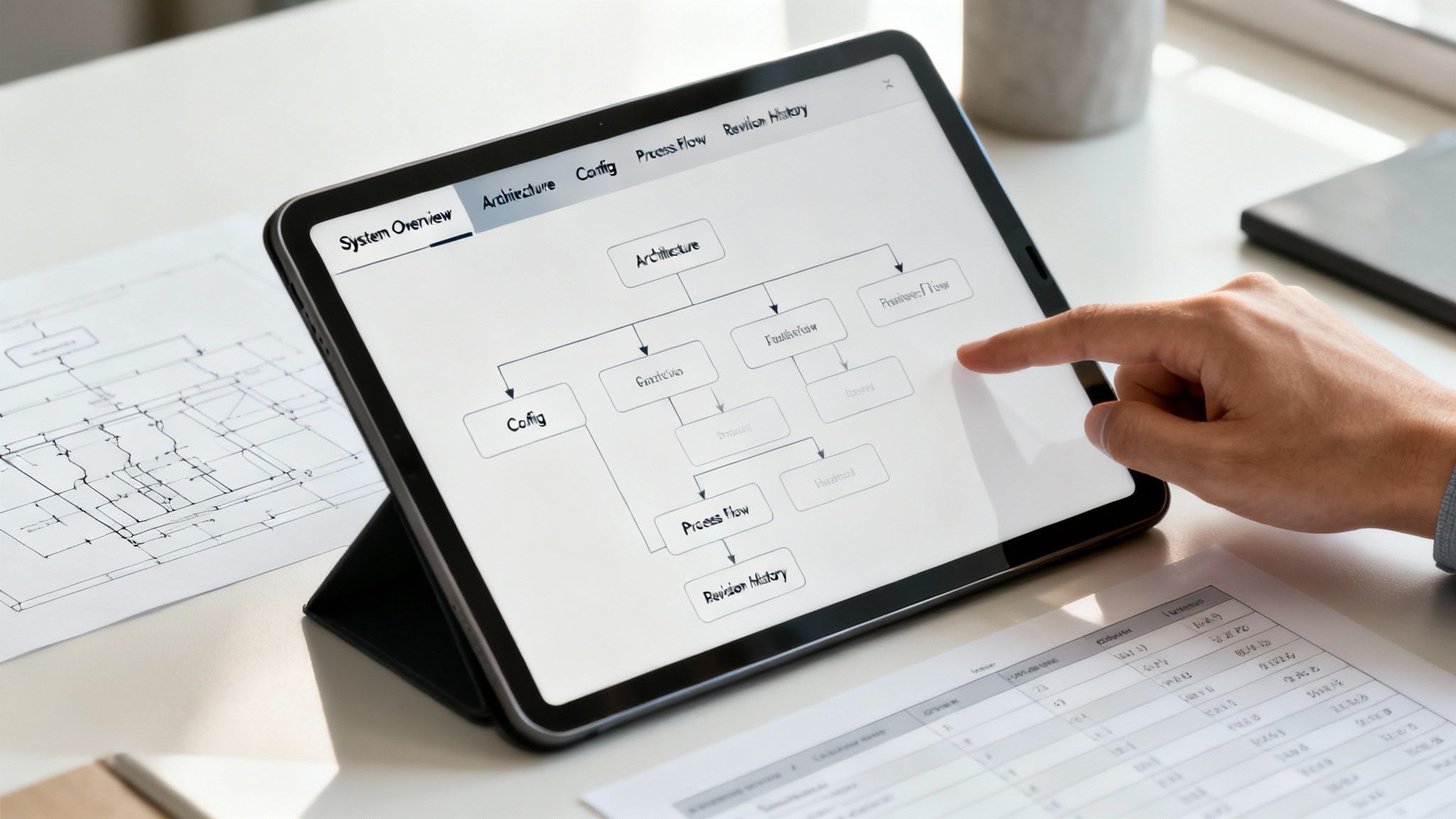Master a software description document template with practical steps, real-world examples, and tips to speed up your documentation process.
Need error-free software documentation in minutes? DocuWriter.ai delivers—start your free trial today!
Standardizing your software description document removes guesswork and keeps every stakeholder on the same page. With templates, you’ll cut documentation time by more than 30%, maintain consistency from system overview through revision history, and foster clarity across the team.

A well-crafted template acts as a bridge between developers, QA engineers, and project managers. Misinterpretations drop dramatically when everyone refers back to the same structure.
Consistency isn’t just aesthetics. Teams save hours that would otherwise go to debating formats or hunting down missing sections.
Those gains translate directly into tighter sprint cycles and more reliable delivery dates.
For example, a 2022 PMI study of 1,200 software projects found that teams using structured templates achieved a 45% higher success rate, experienced 33% fewer post-release bugs, and saved 15 hours per week per team member. Learn more about these findings on faddom.com.
When everyone references the same document outline, designers, engineers, and business stakeholders speak the same language. Feature reviews become faster because no one is guessing where to find critical information.
For more on why documentation matters, see in our detailed post.
Below is a snapshot of what you can expect when you adopt a template-first approach.
Key Benefits Of Template Usage
The table below highlights the core advantages of using a template in your documentation workflow.
These benefits lay the groundwork for the deeper dive that follows.
Imagine a fintech startup where UX designers handed off specs to engineers without confusion or missing details. That’s the kind of frictionless collaboration templates enable.
Integrate these templates into your process and you’ll see:
DocuWriter.ai makes this effortless. It prompts you for project details, auto-fills each section, and keeps everything in sync as requirements evolve:
Link your repo, answer a few quick prompts, and you’ll have a polished software description outline in under a minute.
Next, we’ll unpack each benefit with concrete examples and actionable tips. Ready to let DocuWriter.ai auto-generate your software description document template? Let’s jump in.
A well-crafted template doesn’t just capture requirements—it guides every contributor from developers to stakeholders. With DocuWriter.ai tracking changes and generating content, you get consistency without the extra work.

System overview narratives set the stage by outlining purpose, scope, and user groups. That opening aligns cross-functional teams and clears up any confusion before work begins.
Architecture diagrams bring your design to life by visualizing components and data flows. DocuWriter.ai’s structure generator can drop in a UML or flowchart based on your codebase in seconds. Engineers, QA, and ops all see the same blueprint—no more misinterpretations.
Each of these sections ties neatly into your agile sprints, so updating docs feels like just another backlog item instead of a separate chore.
Below is a quick snapshot of each section and what it aims to achieve:
That overview should help you see where each piece fits into the bigger picture.
Not every project needs the same level of depth. A two-person startup might skip low-level API parameters, while a large enterprise requires exhaustive tables. DocuWriter.ai senses your audience tags and tweaks content scope automatically.
A 2023 survey by the International Association of Software Architects found 78% of teams used structured templates, cutting documentation time by 35% and reducing errors by 22%. Learn more about these findings in this detailed analysis.
By weaving docs into your existing workflow, you keep them up to date as features evolve. When outlining the key elements of a software description document template, it’s crucial to consider the benefits of using standardized documentation templates for consistency and efficiency.
Regular check-ins prevent diagrams from going stale. DocuWriter.ai’s revision tracker flags outdated visuals automatically.
Configuration tables often list environment variables, database connections, and third-party API keys. Keeping this organized prevents onboarding headaches. DocuWriter.ai can populate sample parameters that you simply replace:
Every update should record who changed what and why. A clear revision table cuts down audit friction. DocuWriter.ai logs each edit with a summary comment and timestamp.
Custom elements—like security requirements or glossary entries—slot in seamlessly. With DocuWriter.ai guiding your structure, teams spend less time on paperwork and more time building features. Start generating your template in minutes.
Need a bespoke software description document in minutes? DocuWriter.ai adapts your chosen template with automated structure, version control, and in-line guidance—try it free now!
Before you dive in, explore our deep dive on template design: Mastering Software Documentation Templates
Every project has its own story. Maybe you’re building a mobile wallet that needs PCI compliance and lightning-fast checkouts. In that case, your document must balance technical specs with user journeys so no detail slips through the cracks.
Start by mapping out who’s involved. When developers, QA, compliance, and stakeholders see their roles clearly, you cut down on endless email loops. This clarity shapes which sections get priority and whom you address with each paragraph.
First, pinpoint everyone who plays a part:
Run quick scoping workshops or send out surveys to capture boundaries and acceptance criteria. This exercise guides how deep each section goes and the order you tackle them.
Real-world specs drive a useful document. Gather:
Then, draft user scenarios that reflect actual workflows and edge cases. Don’t forget to note performance goals like 99.9% uptime and response targets under <200 ms. These figures keep your readers—and the system—on track.
Consistency in naming means fewer “Which file is that?” moments. A simple prefix system works wonders:
Set up a pull-request process to spot gaps early on. Good habits include:
Putting your template in Git does more than just store files. It creates an audit trail that ties every change back to its context.